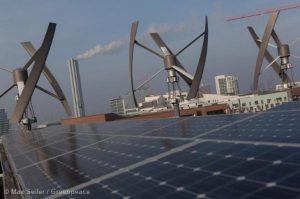Cheap imports threaten to cause factory closures and job losses in Latin America’s steel industry as China’s surplus is ‘dumped’ in the region at prices domestic producers cannot compete with, according to industry representatives. Imports of Chinese steel doubled in the first half of this year compared to the same period in 2014, leading to claims that China’s state-subsidised metalworks companies are trading unfairly.
Rafael Rubio, director general of Latin America’s regional steel association Alacero, tells Diálogo Chino about the impacts of the dramatic rise in Latin American imports of Chinese steel and the importance of establishing “a level playing field” in the international steel trade.
DC: How concerning is the situation regarding imports of Chinese steel?
RR: The situation is very worrying, we would say it has reached alarming levels. The arrival of steel imports under unfair trading conditions, especially from China, is the biggest challenge that Latin American steel producers face today.
To understand the Chinese steel phenomenon you have to go back some 10 years, when China was a net importer of steel. At that time, the Chinese government decided to heavily invest in, develop and promote the steel sector as a strategic industry. Currently, China is the world’s largest steel producer, with a 50% share of the global market (the next five biggest producing countries have a 26% share between them). It is also the world’s biggest steel exporter.
The majority of steel companies in China are state-owned. Such exponential growth is only possible under the logic of a centrally planned economy – unlimited financial resources from the state without being restricted by the need to forecast profits – which is not subject to market rules.
Huge changes in the international steel trade began in 2010, and the impacts are being felt in 2015. Faced with an excessive installed capacity, the Chinese steel industry (which currently produces 425 million tonnes per year, six times that of Latin America) – part of a national economy that was allowed to grow at double-digits – was obliged to “go out” into international markets. By not reducing the rate of production they aimed to ensure job continuity and social stability.
The most effective way to capture new markets is obviously through low prices. And the Chinese government has the financial capacity to subsidise steel at ‘dumping’ prices.
A decade ago, no one in our markets ever mentioned steel from China. But in the last five years, China has more than doubled its presence in Latin America’s market, growing its share from 6% to 13%. In 2014, Latin America received 8.3 million tonnes of steel from China and that figure is expected to rise to 9.7 million this year. Our region has become the second most important export destination for Chinese steel after South Korea.
The Latin American steel industry is competitive and operates according to world class governance, environmental quality and security standards. But these are prices against which Latin American countries, which work according to market conditions, cannot compete.
DC: Who is affected by dumping and how do you expect the situation to be resolved?
RR: The danger is already in sight with strikes, plant closures (as has happened in Chile), technical interruptions (as in Mexico), redundancies (according to figures from Aço Brasil, there were 11,000 redundancies last year) and cancelled investments.
Alacero is leading efforts to bring the message about the dangers of this unfair trade practice to opinion-formers and governments throughout the region, showing the continental dimensions of this problem. The plant closures that are happening in one country today could happen in other one tomorrow. The threat is that we reach a pont of no return.
Specifically, we’re calling on Latin American governments to establish clear rules and to act with strategic vision and decisiveness. Latin American steel companies are in favour of competition and commercial openness but on a playing field that’s level for all competitors. The only way of generating quality employment and the development our economies need is to ensure solid steel and industry bases.
DC: Are Latin American countries less likely to take a complaint against China to the World Trade Organisation (WTO)?
RR: On the contrary, Alacero has presented information demonstrating that Chinese steel imports have arrived under the premise of unfair trading practices. And this is proved by the anti-dumping investigations that a large number of countries have undertaken and completed with resolutions in favour of national companies. And I’m not just referring to Latin American countries, but practically everywhere in the world (the US, Europe, Malaysia, Singapore, India etc.).
There are currently 42 antidumping resolutions being brought by various governments (including Brazil, Mexico, Colombia and Peru), 27 of which are against Chinese products. In North America, the US has 96 antidumping cases, 53 against China and Canada has 16 cases, 10 against China.
I think it’s important to clarify that countries don’t go to the WTO to make complaints, countries have legal instruments to carry out investigations, be they about dumping or subsidies, and they make decisions based on the information they have available. They’re legal processes in which all involved parties participate (producers, importers, exporters, foreign governments). At the end of the process it’s the government that makes the decision.
DC: In what ways are countries affected by Chinese steel dumping responding differently?
RR: The WTO has a series of instruments that guarantee fair competition in international markets. And member countries – which all Latin American countries are – have the right to use them and to apply the corrective measures they contain.
This is how governments can ensure a level playing field.
On detecting a product that is arriving in their markets at excessively low prices, companies look to the precedents that on the one hand prove China is selling lower than it is domestically and on the other hand that this is harming domestic industry financially, in terms of its productivity, its reduced market share, job losses and more.
DC: Are they trying to use diplomatic channels to engage in dialogue with China? What would you like to see national governments do?
RR: A few weeks ago Alacero, along with the national associations of Argentina, Brazil, Colombia, Chile, Mexico and Peru published an open letter to the governments of Latin America in newspapers throughout the region.
In the letter we clearly and specifically describe the urgent, integrated actions that that our governments should undertake to ensure fair competition. They are:
- More effective inspection at customs to avoid unlawful avoidance of antidumping quotas.
- Demand that the same quality assurance policies that apply to national industries also apply to imports.
- Apply timely and efficiently all the instruments set out by the WTO.
- Demand through trade diplomacy that China and its state-owned companies act according to market rules.
- That China not be recognized by the WTO as a market economy. The existence of its steel overcapacity confirms that it continues to be a centrally-planned economy.






